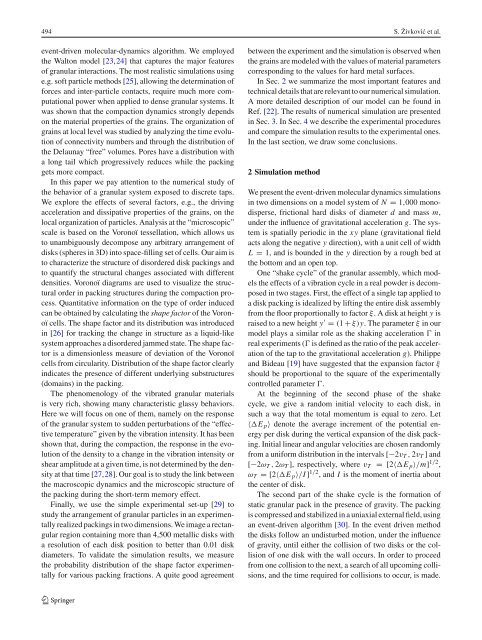Structural characterization of two-dimensional granular ... - Springer
Structural characterization of two-dimensional granular ... - Springer
Structural characterization of two-dimensional granular ... - Springer
You also want an ePaper? Increase the reach of your titles
YUMPU automatically turns print PDFs into web optimized ePapers that Google loves.
494 S. Živković etal.event-driven molecular-dynamics algorithm. We employedthe Walton model [23,24] that captures the major features<strong>of</strong> <strong>granular</strong> interactions. The most realistic simulations usinge.g. s<strong>of</strong>t particle methods [25], allowing the determination <strong>of</strong>forces and inter-particle contacts, require much more computationalpower when applied to dense <strong>granular</strong> systems. Itwas shown that the compaction dynamics strongly dependson the material properties <strong>of</strong> the grains. The organization <strong>of</strong>grains at local level was studied by analyzing the time evolution<strong>of</strong> connectivity numbers and through the distribution <strong>of</strong>the Delaunay “free” volumes. Pores have a distribution witha long tail which progressively reduces while the packinggets more compact.In this paper we pay attention to the numerical study <strong>of</strong>the behavior <strong>of</strong> a <strong>granular</strong> system exposed to discrete taps.We explore the effects <strong>of</strong> several factors, e.g., the drivingacceleration and dissipative properties <strong>of</strong> the grains, on thelocal organization <strong>of</strong> particles. Analysis at the “microscopic”scale is based on the Voronoï tessellation, which allows usto unambiguously decompose any arbitrary arrangement <strong>of</strong>disks (spheres in 3D) into space-filling set <strong>of</strong> cells. Our aim isto characterize the structure <strong>of</strong> disordered disk packings andto quantify the structural changes associated with differentdensities. Voronoï diagrams are used to visualize the structuralorder in packing structures during the compaction process.Quantitative information on the type <strong>of</strong> order inducedcan be obtained by calculating the shape factor <strong>of</strong> the Voronoïcells. The shape factor and its distribution was introducedin [26] for tracking the change in structure as a liquid-likesystem approaches a disordered jammed state. The shape factoris a dimensionless measure <strong>of</strong> deviation <strong>of</strong> the Voronoïcells from circularity. Distribution <strong>of</strong> the shape factor clearlyindicates the presence <strong>of</strong> different underlying substructures(domains) in the packing.The phenomenology <strong>of</strong> the vibrated <strong>granular</strong> materialsis very rich, showing many characteristic glassy behaviors.Here we will focus on one <strong>of</strong> them, namely on the response<strong>of</strong> the <strong>granular</strong> system to sudden perturbations <strong>of</strong> the “effectivetemperature” given by the vibration intensity. It has beenshown that, during the compaction, the response in the evolution<strong>of</strong> the density to a change in the vibration intensity orshear amplitude at a given time, is not determined by the densityat that time [27,28]. Our goal is to study the link betweenthe macroscopic dynamics and the microscopic structure <strong>of</strong>the packing during the short-term memory effect.Finally, we use the simple experimental set-up [29] tostudy the arrangement <strong>of</strong> <strong>granular</strong> particles in an experimentallyrealized packings in <strong>two</strong> dimensions. We image a rectangularregion containing more than 4,500 metallic disks witha resolution <strong>of</strong> each disk position to better than 0.01 diskdiameters. To validate the simulation results, we measurethe probability distribution <strong>of</strong> the shape factor experimentallyfor various packing fractions. A quite good agreementbetween the experiment and the simulation is observed whenthe grains are modeled with the values <strong>of</strong> material parameterscorresponding to the values for hard metal surfaces.In Sec. 2 we summarize the most important features andtechnical details that are relevant to our numerical simulation.A more detailed description <strong>of</strong> our model can be found inRef. [22]. The results <strong>of</strong> numerical simulation are presentedin Sec. 3. In Sec. 4 we describe the experimental proceduresand compare the simulation results to the experimental ones.In the last section, we draw some conclusions.2 Simulation methodWe present the event-driven molecular dynamics simulationsin <strong>two</strong> dimensions on a model system <strong>of</strong> N = 1,000 monodisperse,frictional hard disks <strong>of</strong> diameter d and mass m,under the influence <strong>of</strong> gravitational acceleration g. The systemis spatially periodic in the xy plane (gravitational fieldacts along the negative y direction), with a unit cell <strong>of</strong> widthL = 1, and is bounded in the y direction by a rough bed atthe bottom and an open top.One “shake cycle” <strong>of</strong> the <strong>granular</strong> assembly, which modelsthe effects <strong>of</strong> a vibration cycle in a real powder is decomposedin <strong>two</strong> stages. First, the effect <strong>of</strong> a single tap applied toa disk packing is idealized by lifting the entire disk assemblyfrom the floor proportionally to factor ξ. A disk at height y israised to a new height y ′ = (1 + ξ)y. The parameter ξ in ourmodel plays a similar role as the shaking acceleration Ɣ inreal experiments (Ɣ is defined as the ratio <strong>of</strong> the peak acceleration<strong>of</strong> the tap to the gravitational acceleration g). Philippeand Bideau [19] have suggested that the expansion factor ξshould be proportional to the square <strong>of</strong> the experimentallycontrolled parameter Ɣ.At the beginning <strong>of</strong> the second phase <strong>of</strong> the shakecycle, we give a random initial velocity to each disk, insuch a way that the total momentum is equal to zero. Let〈E p 〉 denote the average increment <strong>of</strong> the potential energyper disk during the vertical expansion <strong>of</strong> the disk packing.Initial linear and angular velocities are chosen randomlyfrom a uniform distribution in the intervals [−2v T , 2v T ] and[−2ω T , 2ω T ], respectively, where v T = [2〈E p 〉/m] 1/2 ,ω T =[2〈E p 〉/I ] 1/2 , and I is the moment <strong>of</strong> inertia aboutthe center <strong>of</strong> disk.The second part <strong>of</strong> the shake cycle is the formation <strong>of</strong>static <strong>granular</strong> pack in the presence <strong>of</strong> gravity. The packingis compressed and stabilized in a uniaxial external field, usingan event-driven algorithm [30]. In the event driven methodthe disks follow an undisturbed motion, under the influence<strong>of</strong> gravity, until either the collision <strong>of</strong> <strong>two</strong> disks or the collision<strong>of</strong> one disk with the wall occurs. In order to proceedfrom one collision to the next, a search <strong>of</strong> all upcoming collisions,and the time required for collisions to occur, is made.123
















